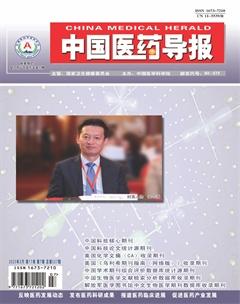维生素D及其受体在糖尿病肾病发病中的研究进展
付佳 徐琪 韩睿
[摘要] 糖尿病肾病是由糖尿病慢性微血管病变所引起的肾脏结构和功能的异常的病变,是糖尿病中晚期最常见并发症之一,也是糖尿病患者死亡的主要原因之一。由于糖尿病肾病发病机制复杂,目前尚无有效的治疗方法预防或减缓糖尿病肾病的发生、发展。随着近年对维生素D及其受体的深入研究发现,维生素D不仅能够调节钙、磷代谢和维持骨骼结构,在许多临床及动物实验研究中观察到维生素D的缺乏和糖尿病肾病间存在一定相关性。维生素D可以通过抗炎、抗氧化应激、抑制肾素-血管紧张素-醛固酮系统活性、保护足细胞等相关机制延缓糖尿病肾病的进展。本文将阐述维生素D及其受体对糖尿病肾病发病机制的相关影响及研究进展。
[关键词] 糖尿病肾病;维生素D;维生素D受体;发病机制
[中图分类号] R587.2 [文献标识码] A [文章编号] 1673-7210(2020)03(a)-0023-04
[Abstract] Diabetic kidney disease is an abnormal pathological change in the structure and function of the kidney caused by diabetic chronic microangiopathy. It is one of the most common complications in the middle and advanced stages of diabetes. It is also the leading cause of death in diabetic patients. Because of the complex pathogenesis of diabetic nephropathy, there is no effective treatment to prevent or slow the occurrence and development of diabetic nephropathy now. With the deep studies of vitamin D and its receptors in the past years, it has been found that vitamin D can regulate calcium and phosphorus metabolism and maintain bone structure. In many clinical and animal experimental studies, it has been observed that there is a certain correlation between vitamin D deficiency and diabetic kidney disease. Vitamin D can postpone the progression of diabetic kidney disease through related mechanisms such as anti-inflammatory, anti-oxidative stress, inhibition of renin-angiotensin-aldosterone system activity, and protection of podocyte. This article reviews the related effects and research progress of vitamin D and its receptors on the pathogenesis of diabetic kidney disease.
[Key words] Diabetic kidney disease; Vitamin D; Vitamin D receptor; Pathogenesis
糖尿病腎病(DKD)是糖尿病最常见的慢性并发症,也是导致终末期肾脏疾病的主要原因。一项ADVANCE研究显示[1],我国糖尿病患者的DKD发生率是白种人的1.73倍,且男性的DKD发生率和进展速度远高于女性。DKD发病机制复杂,目前认为DKD的发生和发展与血流动力学异常、糖代谢紊乱、氧化应激、炎性反应及足细胞损伤等诸多因素有关。近年来一些研究发现维生素D(Vit D)及其受体(VDR)与DKD的进展密切相关。因此,本文将对DKD发病机制和Vit D及VDR对DKD的可能影响机制进行综述。
1 DKD发病机制研究
1.1 血流动力学异常
肾素-血管紧张素-醛固酮系统(RAAS)是动脉血压、水和钠稳态的主要调节剂,在维持肾血流动力学以及调节肾脏钠转运中起关键作用。在体内高糖环境的不断刺激下,RAAS系统被激活,释放出的血管紧张素Ⅱ(Ang Ⅱ)导致肾小球内压力增加和大量蛋白尿的产生,蛋白尿通过局部促炎和促硬化作用进一步加快肾小球肥大和硬化的发展[2]。Ang Ⅱ通过不断刺激磷脂酰肌醇的生成,使蛋白激酶C(PKC)产生增加,进而激活PKC信号通路,并可以通过降低纤溶酶原激活剂的活性来抑制近端小管中的蛋白酶活性从而引起肾小球系膜细胞扩张。此外,Ang Ⅱ还可通过激活促炎和促纤维化因子如NF-κB、MCP-1和TGF-β的释放[3],从而加快肾小球硬化,加速DKD的进展。
1.2 氧化应激
活性氧(ROS)是高度反应性的信号分子,在维持氧化还原稳态中起重要作用。当机体遭受刺激后,体内ROS的产生过多,氧化程度超出氧化物的清除能力,从而导致组织损伤。Namazi等[4]研究显示,DKD的发生机制与强氧化应激状态下大量ROS参与有关。此外,糖代谢的异常可以导致线粒体超氧化物的产生过多,引起包括晚期糖基化终产物(AGEs)形成增加、蛋白激酶C活化以及多元醇途径等有害通路的激活,进而导致ROS的产生增多[5],进一步加重氧化应激反应。此外,DKD时细胞内炎症信号通路的激活如磷脂酰3肌醇激酶(PI-3K)信号通路、c-Jun氨基末端激酶(c-JNK)信号通路、p38丝裂原活化蛋白激酶(MAPK)等也可使体内氧化应激反应增加,加重肾脏的损伤。
2.4 足细胞保护作用
研究发现,Vit D及VDR具有足细胞保护作用。机体在高糖状态下,内皮细胞、肾小球基底膜和足细胞开始发生解剖异常,血管通透性增加,加速蛋白尿的发生;此外,足细胞数量减少导致无法维持肾小球滤过屏障的完整性[24],使蛋白尿产生过多,进而加快DKD的进展。Sanchez-Ni?觡o等[25]研究发现,VDR激活可减少糖尿病肾病模型中的肾脏炎症和足细胞凋亡,并且Vit D的抗炎作用也可能有助于抑制足细胞凋亡。在一项针对狼疮性肾炎的研究[26]中还发现了Vit D可通过抑制足细胞异常自噬起到肾脏保护作用。足细胞自噬作为DKD主要发病机制之一,还可通过mTOR的活性来改善DKD症状。Wang等[27]发现,Vit D的活性形式1,25-(OH)2-D3对肾脏的保护作用与mTOR和P70S6K的磷酸化状态有关,经过1,25-(OH)2-D3处理的大鼠系膜细胞可以减少哺乳动物雷帕霉素靶标的磷酸化,提示1,25-(OH)2-D3可以有效抑制高血糖诱导的大鼠系膜细胞增殖,从而抑制DKD的发展。
综上所述,随着DKD发病机制研究不断深入,研究发现Vit D及其受體可以通过抗炎、抗氧化应激、抑制RAAS,改善足细胞损伤等不同作用机制延缓DKD的发病及进展。尽管其发病机制尚未完全明确,但为延缓DKD发展,减少终末期肾病的发生提供了一定理论依据,也为临床治疗DKD提供了新的思路和方法。
[参考文献]
[1] Maric C. Sex,diabetes and the kidney [J]. Am J Physiol Renal Physiol,2009,296(4):680-688.
[2] Ibrahim AH,Omar HH,Imam AM,et al. 25-hydroxyvitamin D Deficiency and Predictive Factors in Patients with Diabetic Nephropathy in Type 2 Diabetes Mellitus [J]. Egypt J Immunol,2018,25(2):11-20.
[3] Ruggenenti P,Cravedi P,Remuzzi G. The RAAS in the pathogenesis and treatment of diabetic nephropathy [J]. Nat Rev Nephrol,2010,6(6):319-330.
[4] Namazi SN,Saberi FS,Falak R,et al. Phosphodiesterase 4 and 7 inhibitors produce protective effects against high glucose-induced neurotoxicity in PC12 cells via modulation of the oxidative stress,apoptosis and inflammation pathways [J]. Metab Brain Dis,2019, 33(4):1293-1306.
[5] Luis-Rodríguez D,Martínez-Castelao A,Górriz JL,et al. Pathophysiological role and therapeutic implications of inflammation in diabetic nephropathy [J]. World J Diabetes,2012,3(1):7-18.
[6] Ahmad J. Management of diabetic nephropathy: Recent progress and future perspective [J]. Diabetes Metab Syndr,2015,9(4):343-358.
[7] Duran-Salgado MB,Rubio-Guerra AF. Diabetic nephropathy and Inflammation [J]. World J Diabetes,2014,5(3):393-398.
[8] Haoran D,Qingquan L,Baoli L. Research Progress on Mechanism of Podocyte Depletion in Diabetic Nephropathy [J]. J Diabetes Res,2017,2017:1-10.
[9] Lin YC,Chang YH,Yang SY,et al. Update of pathophysiology and management of diabetic kidney disease [J]. J Formos Med Assoc,2018,117(8):662-675.
[10] Issa CM. Vitamin D and Type 2 Diabetes Mellitus [J]. Adv Exp Med Biol,2017,996:193-205.
[11] Hu X,Liu W,Yan Y,et al. Vitamin D protects against diabetic nephropathy: evidence-based effectiveness and mechanism [J]. Eur J Pharmacol,2019,845:91-98.
[12] Guan X,Yang H,Zhang W,et al. Vitamin D receptor and its protective role in diabetic nephropathy [J]. Chin Med J (Engl),2014,127(2):365-369.
[13] 王雪,李英.维生素D延缓糖尿病肾病的研究进展[J].临床荟萃,2018,33(3):267-270.
[14] Deng X,Cheng J,Shen M. Vitamin D improves diabetic nephropathy in rats by inhibiting renin and relieving oxidative stress [J]. J Endocrinol Invest,2016 ,39(6):657-666.
[15] Li YC,Kong J,Wei M,et al. 1,25-Dihydroxyvitamin D(3) is a negative endocrine regulator of the renin-angiotensin system [J]. J Clin Invest,2002,110(2):229-238.
[16] Chandel N,Ayasolla K,Wen H,et al. Vitamin D Receptor Deficit Induces Activation of Renin Angiotensin System Via SIRT1 Modulation in Podocytes [J]. Exp Mol Pathol,2017,102(1):97-105.
[17] Rui X,Dingkun G,Liyang Z,et al. Mechanistic Insight and Management of Diabetic Nephropathy: Recent Progress and Future Perspective [J]. J Diabetes Res,2017, 2017:1-7.
[18] Rai P,Singh T,Lederman R,et al. Hyperglycemia enhances kidney cell injury in HIVAN through down-regulation of vitamin D receptors [J]. Cell Signal,2015,27(3):460-469.
[19] Thethi TK,Bajwa MA,Ghanim H,et al. Effect of paricalcitol on endothelial function and inflammation in type 2 diabetes and chronic kidney disease [J]. J Diabetes Complications,2015,29(3):433-437.
[20] Nakai K,Fuj H,Kono K,et al. Vitamin D activates the Nrf2-Keap1 antioxidant pathway and ameliorates nep-hropathy in diabetic rats [J]. Am J Hypertens,2014,27(4):586-595.
[21] Deb DK,Chen Y,Zhang Z,et al. 1,25-Dihydroxyvitamin D3 suppresses high glucose-induced angiotensinogen expression in kidney cells by blocking the NF-κB pathway [J]. Am J Physiol Renal Physiol,2009,296(5):F1212-F1218.
[22] Chokhandre MK,Mahmoud MI,Hakami T,et al. Vitamin D & its analogues in type 2 diabetic nephropathy: a systematic review [J]. J Diabetes Metab Disord,2015,4:58.
[23] Silvia L,Adriana A,Giovanna S,et al. Role of Paricalcitol in Modulating the Immune Response in Patients with Renal Disease [J]. Int J Endocrinol,2015,2015:1-8.
[24] Gembillo G,Cernaro V,Salvo A,et al. Role of Vitamin D Status in Diabetic Patients with Renal Disease [J]. Medicina (Kaunas),2019,55(6):273.
[25] Sanchez-Ni?觡o MD,Bozic M,Córdoba-Lanús E,et al. Beyond proteinuria: VDR activation reduces renal inflammation in experimental diabetic nephropathy [J]. Am J Physiol Renal Physiol,2012,302(6):F647-657.
[26] Yu Q,Qiao Y,Liu D,et al. Vitamin D protects podocytes from autoantibodies induced injury in lupus nephritis by reducing aberrant autophagy [J]. Arthritis Res Ther,2019,21(1):19.
[27] Wang H,Wang J,Qu H,et al. In vitro and in vivo inhibition of mTOR by 1,25-dihydroxy vitamin D3 to improve early diabetic nephropathy via the DDIT4/TSC2/mTOR pathway [J]. Endocrine,2016,54(2):348-359.
(收稿日期:2019-12-25 本文編辑:王晓晔)

